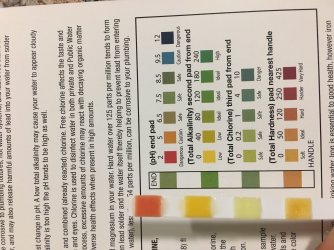If you measure PH, GH, and KH daily you probably will be surprised. Using tetra easy strips it is easy to check several times per day. Right now I have noticed by PH in the morning lights off is low but by the time I get home with the lights on it pegs the strip to its maximum level. Still not sure exactly why but it might be due to a fertilizer plant growth interaction. I have also seen some fast KH changes a couple of years ago. And when I got home from christmas holiday I found my water hardness had taken a substantial drop due to plant growth and no fertilizer for 2 weeks while I was gone.
Not meaning to hijack the OP's thread, but this may be of value to others too.
I have actually run some concentrated tests, though not recently. It was about two years back when I was advised I needed to up the GH for the plants (I knew they had a calcium deficiency). I was carrying out regular tests twice a day for GH and pH over a period of several weeks to months. After the first few weeks I trimmed these back, as the consistency was clear, and they have stopped during this past year. I concentrated on the GH and pH. Tap values were (and still are) GH 7 ppm (according to water authority; API test turned colour at 1), KH presumed near zero (API test turned colour at 1) and pH 7.0 to 7.2 due to addition of soda ash (sodium carbonate) by municipality to raise the natural pH which was close to 5 before they began using this in 2001.
I used Equilibrium to raise the GH to 4 or 5 dGH, in three of seven tanks; all seven also received Flourish Comprehensive, once weekly. No other additives. The GH remained at 4 (or 5) for the entire week; a 50-60% water change reduced it by exactly half, so at each water change I added sufficient Equilibrium to return it to 4 (or 5). Over a period of a few weeks experimenting (very gradual increase of Equilibrium added) I got this down exact. For months it never varied. The plants definitely improved (calcium deficiency disappeared), but the GH using the API liquid test never lowered during the week. Obviously it may have gone down a tad, but not sufficient to register.
The pH remained constant within each tank. The three receiving the Equilibrium remained in the low to mid 6's, while the pH in the other tanks remained below 6 or in the low 6's depending upon the tank, as it always had/has. The 50-60% water change raises the pH by 0 to 0.2, never more. This puzzled me a bit, until I learned that the soda ash is not permanent and easily dissipates out. I also assume that after several months, each tank's biological system was fairly stable and easily handled these sort of minor fluctuations. When I set up a new tank, the pH remains close to 7 for a couple weeks, then lowers as the system establishes, and stabilizes.
The diurnal pH shift common to planted tanks, which is what you observed in your own tanks, is minor in mine. I have found it to be 0.4 max. The Equilibrium seemed to have no affect on this. This fluctuation is of course due to the CO2 level changing, from its highest in the early morning after building over darkness to its lowest in the late afternoon after the plants had used most of it.
I discontinued Equilibrium about 15 months back, as part of resolving another issue in the 90g that I won't go into as it is unrelated. But to deal with the calcium deficiency, which did begin to reappear, I am now using Flourish Tabs next to the larger swords, aponogeton, red tiger lotus and a couple crypts. I replace these every second month, more often that the recommended 3-4 months, and it has worked; the plants are thriving without raising the GH a tad. I reduced the liquid Flourish Comp to deal with brush algae, and that worked. I seem to have got things balanced now, light and additives; the GH and KH is basically zero in all 8 tanks, and the pH is stable tank by tank, arolund 5 up to mid 6 depending upon the tank. I use the aragonite "buffer" in the 33g to maintain a pH of 6.6 solely for those fish.
Byron.

 ?
?


